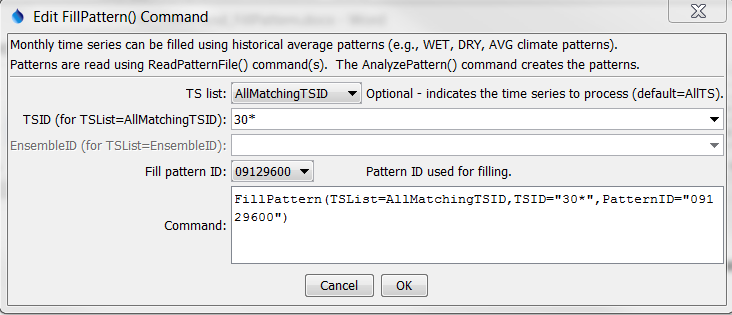TSTool / Command / FillPattern
Overview
The FillPattern command fills missing data
in a time series using historical averages based on a pattern file.
For example, if May 1910 is missing and the pattern indicates that May 1910 is a WET month,
then the average of all WET Mays is used to fill the time series.
The pattern file indicates the WET/DRY/AVG patterns and the time series
to be filled supplies data to compute averages, for use in filling.
This feature is enabled for monthly data only.
Averages are computed as described for the
FillHistMonthAverage command.
There is currently no way to limit the fill operation to a period (the entire time series is filled).
The pattern file is created with the
AnalyzePattern command and a saved file must be read with a
ReadPatternFile command.
See below for an example of a fill pattern file.
One or more patterns can be included in each pattern file,
similar to StateMod time series files (see the StateMod Input Type appendix).
Multiple pattern files can be used, if appropriate.
# Years Shown = Water Years
# Missing monthly data filled by the Mixed Station Method, USGS 1989
# Time series identifier = 09034500.CRDSS_USGS.QME.MONTH.1
# Description = COLORADO RIVER AT HOT SULPHUR SPRINGS, CO.
# -e-b----------eb------eb------eb------eb------eb------eb------eb------eb------eb------eb------eb------eb------eb--------e
10/1908 - 9/1996 ACFT WYR
1909 09034500 AVG AVG AVG WET WET AVG AVG AVG WET WET WET WET
1910 09034500 WET WET WET WET WET WET AVG AVG AVG AVG AVG AVG
1911 09034500 AVG AVG WET AVG AVG AVG AVG WET WET WET AVG WET
1912 09034500 WET WET WET WET WET AVG AVG WET WET WET WET WET
...ommitted...
Command Editor
The following dialog is used to edit the command and illustrates the syntax of the command.

FillPattern Command Editor (see also the full-size image)
Command Syntax
The command syntax is as follows:
FillPattern(Parameter="Value",...)
Command Parameters
| Parameter | Description | Default |
|---|---|---|
TSList |
Indicates the list of time series to be processed, one of:
|
AllTS |
TSID |
The time series identifier or alias for the time series to be processed, using the * wildcard character to match multiple time series. Can be specified using ${Property}. |
Required if TSList=*TSID |
EnsembleID |
The ensemble to be processed, if processing an ensemble. Can be specified using ${Property}. |
Required if TSList=*EnsembleID |
PatternIDrequired |
The pattern identifier, matching a pattern read with ReadPatternFile commands. |
None – must be specified |
Examples
See the automated tests.
A sample command file to process data from the State of Colorado’s StateMod model is as follows.
The example fills all diversion time series with identifier starting with 30, using the pattern 09034500
(a stream gage for the region that was analyzed to determine patterns).
# Read StateMod time series to fill
ReadStateMod(InputFile="..\StateMod\sjm_prelim.ddh")
# Read the file containing the patterns
ReadPatternFile(PatternFile="fill.pat")
# Fill time series having identifiers that start with "30"
FillPattern(TSList=AllMatchingTSID,TSID="30*",PatternID="09034500")
# Write the results
WriteStateMod(TSList=AllTS,OutputFile="..\StateMod\sjm.ddh")
The above example fills all diversion time series with identifier starting with 30,
using the pattern 09034500 (a stream gage for the region).
Troubleshooting
See Also
AnalyzePatterncommandFillHistMonthAveragecommandReadPatternFilecommandSelectTimeSeriescommand